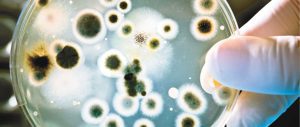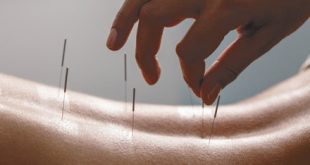By Julie S. Hurst- Nicoll, MBA, CMI, CMR
President, American Mold Experts


Many of you may not have heard about mycotoxins, so let’s start at the beginning. Many common molds produce a byproduct called mycotoxins. As the name implies, these are toxic chemical molecules (non-living) produced by mold in a colony. For mold, they serve two purposes: a) as a waste product, similar to how human bodies produce waste, and b) the poison helps the mold thrive against competitors in their environment, such as bacteria.
But how do they spread and cause problems for humans?
They become aerosolized. Think about hairspray or spray paint—these are particles distributed by compressed air.
Mold in your home, even inside your walls, can be affected by air as well. Many things can create airflow in your home, including walking around, vacuuming, running a fan, temperature changes, storms, and running the AC or heater.
A mold colony releases spores, as well as many spore fragments and mycotoxins that can travel on these spores and fragments or even solo. Once released, mycotoxins can also float around and end up stuck to dust, dander, smoke, and other particles in your home.
Because mycotoxins are incredibly small, they end up everywhere and can easily travel through your HVAC system. They can lodge in your books, clothes, appliance motors, and more. They can even travel with you if you move to a new house.
They cannot be ‘killed,’ but they can be cleaned or transformed into harmless compounds by things like enzyme formulations.
How can you keep yourself safe?
Evaluate your home:
1. Is your humidity controlled and always under 55-60%? Purchase several humidity meters and place them throughout your home to keep a regular check. During our Florida cooler months, the HVAC may not run as much, and that is the main vehicle that dehumidifies our home.
2. Do you see any visible mold? Mold in our shower is common, but if you see mold on drywall or furniture, then you need to be concerned. Mold is microscopic, and by the time you see a 1″ square, it contains millions of spores.
3. Clean your home regularly. Mold loves to feed off dust.
4. Check for leaks under sinks and around the house. Mold starts to form colonies between 48-72 hours.
5. Living in Florida, I personally do not have any raw wood, wicker baskets, wreaths, or rattan furniture—mold loves it.
This is not an exhaustive list but a few items to keep in mind. If you have had previous mold remediation but still have possible health issues, it might be mycotoxins still lurking around. Traditional mold remediation (biological remediation) does not address the remediation of mycotoxins (chemical remediation). Very few companies address both mold and mycotoxins.
If you need more information, please reach out to info@americanmoldexperts.com or visit www.AMEswfl.com.
Call today to schedule an assessment!
239-572-2216 or visit www.AMEswfl.com
Julie S. Hurst- Nicoll, MBA, CMI, CMR
President, American Mold Experts
Serving Central Indiana & Southwest Florida
(Other States for Mold Toxic Patients/Clients Upon Arrangement)
Mold Inspections, Testing & NON-Destructive Remediation
Clearance Testing is ALWAYS INCLUDED in Warranted Jobs (excluding States that forbid clearance by Remediation
Company, ie Florida)
A+ Accredited Better Business Bureau (BBB)
IICRC Certified Company
FL License MRSA 3097, MRSR 3248
 Southwest Florida's Health and Wellness Magazine Health and Wellness Articles
Southwest Florida's Health and Wellness Magazine Health and Wellness Articles

